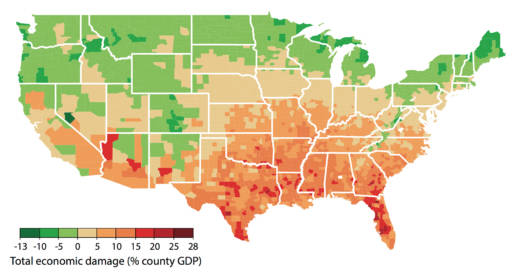Climate scientists agree that this century is getting much warmer and that such warming will likely bring economic pain to the U.S., but economists aren’t sure how much. Now, a team of scientists and economists, writing in the upcoming issue of the journal Science, says it can at least tell which parts of the country are likely to suffer the most.
The researchers started with history: How have heat waves and drought affected the economy in the past? Then they applied that metric to a range of future warming scenarios — from minor to extreme — and mapped the effects, county by county across the U.S. They found that if warming continues at recent rates, it could shave 3 to 6 percentage points off of the country’s gross domestic product by century’s end — the warmer it gets, the bigger the hit to the economy.
Lead researcher Solomon Hsiang acknowledges that the numbers are uncertain by scientific standards but that they aren’t really the bottom line. “I think the takeaway message that is most striking is that the effects of climate change on the U.S. are not the same everywhere,” says Hsiang, an economist at the University of California, Berkeley. “Where you are in the country really matters.”
Colder places like New England might see an economic upturn — for example, from lower heating bills. But places that are already hot, like the South and Midwest, could see huge damage to their local economies, due to enormous electric bills, dying crops or mass migration away from the area.
Maybe that is not so surprising, but Hsiang takes it a step further: Climate change will redistribute wealth by driving workers, businesses and agriculture away from those hard-hit regions and move them mostly toward the north and west of the country. Again, Hsiang says exactly how much is hard to predict. But he says that is actually part of the new study’s findings: “When you start changing the climate,” he says, “it starts affecting all these aspects of the economy, and it makes the future world harder to predict.”

9(MDAxOTAwOTE4MDEyMTkxMDAzNjczZDljZA004))
